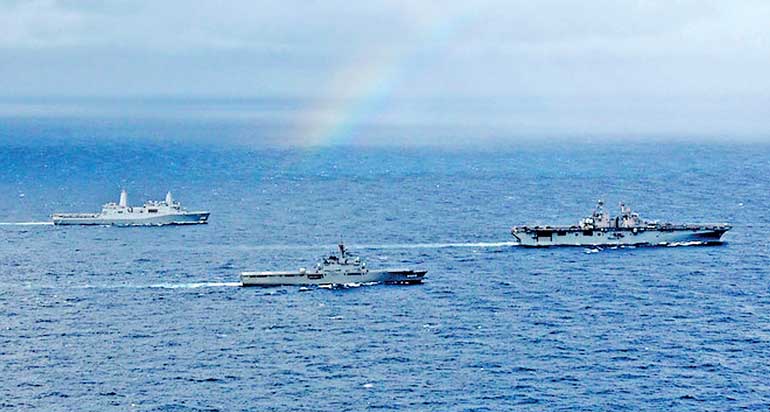Wednesday Dec 24, 2025
Wednesday Dec 24, 2025
Tuesday, 29 November 2022 01:47 - - {{hitsCtrl.values.hits}}

The growing presence of the super powers in this region will make non-aligned countries more vulnerable to power struggles between superpowers in the Indian Ocean region
By Dammika Adhikari
The Indian Ocean is one of the busiest oceans which facilitates one-third of cargo and links strategically important sea lanes of communication between Africa, Asia and Australia. The most significant thing in this ocean at any given time is that more than 120 ships are sailing for various destinations. Today, the Indian Ocean is becoming more vulnerable to power struggles between world superpowers.
The Chinese roadmap of the Belt and Road Initiative provided an avenue to develop more Chinese-funded seaports in various countries such as Gwadar in Pakistan which support warm water access to Chinese goods through the China-Pakistan economic corridor. Apart from that, Chittenango port has been constructed with the help of Chinese funds and is used for access to the China and Bangladesh economic corridor, China-Burma economic corridor design to facilitate through Kyaukphyu port in the Indian Ocean. Hambantota port has been constructed with the help of Chinese funds and presently 90 years of lease to a Chinese company.
China has expanded its sphere of interest to the Western part of the Indian Ocean in African region countries to support financially and technically building several seaports including Luma and Mombasa ports in Kenya, Bagamoyo and Dar es Salam port in Tanzania, Doraleh Multipurpose Port in Djibouti, CSP terminal in Port Khalifa in UAE, Beria fishing port in Mozambique, Tamatave Port in Madagascar and Tecobaine project in Mozambique. The Chinese military presence in Djibouti has been facilitating the Chine Navy operations in the region.
India is considered the emerging superpower in the region and it has expanded its military power to address the growing external and internal threats to the country. India has more than 1,500 long land boundaries along its traditional rival which had a war between the two countries in 1962. The recent confrontations along the border have escalated the tension between the two countries. India is considered the regional power in the Indian Ocean which is challenged by the growing presence of its traditional rival. Bluewater capability is one of the key characteristics of modern warfare. India’s naval power is based on three Command theatres such Southern, Eastern and western.
The recent expansion of blue water capabilities of the Indian Navy, and regional cooperation among the external regional powers boosted its ability to dominate the Indian Ocean. India provided Iran with technological and financial support to construct Chanbar warm water seaport to facilitate central and west Asian countries to send their goods and products to the sea line of communication in the Indian Ocean. The agreements with Mauritius, Seychelles and Madagascar provided an opportunity to the Indian Navy to ensure a sound presence in the West Indian Ocean region. Apart from that, in the year 2015 India provided its support to develop Agaléga Island in Mauritius and undertook a large number of infrastructure development projects on Seychelles Island.
The strategic Indian military presence has been observed in countries such as Uganda, Lesotho and Tanzania. Agreement with the French to use naval facilities on Reunion Island will enhance the Indian naval presence in the Indian Ocean.
Quadrilateral Security Dialogue (Quad), Australia, Japan the United States of America with India join to ensure the security of the Indo Pacific Oceans, regional cooperation among the member states, support for search and rescue operations and curtail the activities of its traditional rivals. India has exploited its economic potential through the SAGAR project in the year 2015 stating, “Our vision for the Indian Ocean region is root advancing cooperation in our region and using the capabilities of all in our common maritime home.” India has more than 7,517 km along the coastal belt with an exclusive economic zone and more than 80% of cargo transport through this route. The strategic presence along the sea routes provides an additional advantage over other regional powers.
Apart from that, assistance has been provided to more Western African countries and countries in the Bay of Bengal to enhance their coastal maritime surveillance systems. Freedom of navigation is one of the critical factors discussed several times; this concept emerged in 2018 and several countries agreed to support this initiative to ensure free and fair navigation through the sea line of communication. The growing presence of the super powers in this region will make non-aligned countries more vulnerable to power struggles between superpowers in the Indian Ocean region.
(The writer has Bachelors and Masters in security and strategic studies from the General Sir John Kotelawla Defense University and experience in discussing international relations at various levels for over 10 years.)